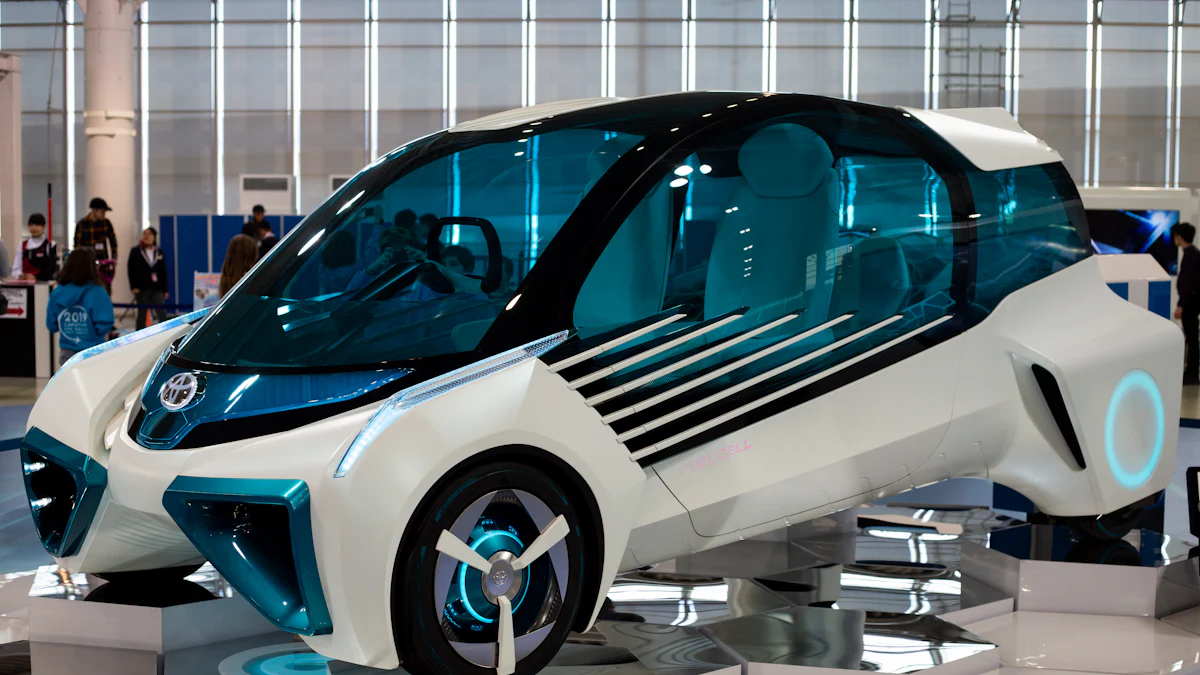What are the different types of fuel cells?

Fuel cells represent a significant advancement in energy conversion technology. Fuel cells generate electricity through electrochemical reactions, offering a cleaner and more efficient alternative to traditional combustion methods. The importance of fuel cells lies in their potential to reduce greenhouse gas emissions and reliance on fossil fuels. What are the different types of fuel cells? Each type has unique characteristics and applications, contributing to diverse energy solutions. Understanding these differences is crucial for advancing sustainable energy technologies.
Proton Exchange Membrane Fuel Cells (PEMFC)

Description and Working Principle
Basic operation and components
Proton Exchange Membrane Fuel Cells (PEMFC) use a polymer electrolyte membrane to conduct protons. Hydrogen gas enters the anode side, where a catalyst splits hydrogen molecules into protons and electrons. Protons pass through the membrane, while electrons travel through an external circuit, generating electricity. The cathode combines protons, electrons, and oxygen to form water.
Electrochemical reactions involved
PEMFCs rely on specific electrochemical reactions. At the anode, hydrogen molecules split into protons and electrons. The reaction at the cathode involves oxygen combining with protons and electrons to produce water. These reactions result in efficient energy conversion.
Advantages and Disadvantages
High efficiency and low emissions
PEMFCs offer high efficiency in energy conversion. The process produces only water and heat as byproducts, leading to low emissions. This makes PEMFCs environmentally friendly.
Cost and durability challenges
PEMFCs face challenges related to cost and durability. The materials required for construction can be expensive. Durability issues arise from the degradation of components over time.
Operating Conditions and Applications
Temperature and pressure requirements
PEMFCs operate at relatively low temperatures, typically between 60°C and 80°C. The system requires precise pressure management to maintain efficiency. These conditions make PEMFCs suitable for various applications.
Use in transportation and portable power
PEMFCs find applications in transportation, including fuel cell vehicles. The technology also powers portable devices, providing reliable energy solutions. These applications highlight the versatility of PEMFCs.
Solid Oxide Fuel Cells (SOFC)

Description and Working Principle
High-temperature operation
Solid Oxide Fuel Cells (SOFC) operate at high temperatures, typically between 600°C and 1000°C. This temperature range allows SOFCs to achieve high efficiency in energy conversion. The heat generated can be used for additional power production. High-temperature operation enables the use of various fuels.
Materials used in construction
SOFCs use ceramic materials for construction. These materials provide stability at elevated temperatures. The electrolyte consists of a solid oxide, such as zirconia. Electrodes are often made from nickel-based materials. These components contribute to the durability and performance of SOFCs.
Advantages and Disadvantages
Fuel flexibility and efficiency
SOFCs offer flexibility in fuel choice. Natural gas, biogas, and hydrogen can serve as fuel sources. This flexibility enhances the versatility of SOFCs. High efficiency results from the direct conversion of chemical energy to electrical energy. The process minimizes energy loss.
High operating temperature issues
High operating temperatures present challenges. Material degradation can occur over time. This affects the lifespan of the fuel cell. Cooling systems may be necessary to manage heat. These factors impact the overall cost and maintenance.
Operating Conditions and Applications
Stationary power generation
SOFCs are ideal for stationary power generation. Large-scale power plants utilize SOFC technology. The ability to operate continuously makes SOFCs suitable for base-load power. The integration with combined heat and power systems enhances efficiency.
Industrial applications
Industries benefit from SOFCs through efficient energy use. Chemical plants and refineries implement SOFCs for power needs. The capability to use waste gases as fuel adds value. Industrial applications highlight the adaptability of SOFCs.
Alkaline Fuel Cells (AFC)
Description and Working Principle
Use of alkaline electrolyte
Alkaline Fuel Cells (AFC) utilize an alkaline electrolyte, typically potassium hydroxide, to facilitate the flow of ions. The electrolyte allows hydroxide ions to move from the cathode to the anode. This movement is essential for the electrochemical reactions within the cell. The use of an alkaline medium differentiates AFCs from other types of fuel cells.
Electrochemical reactions
Electrochemical reactions in AFCs involve hydrogen and oxygen. Hydrogen gas enters the anode, where it reacts with hydroxide ions to produce water and electrons. The electrons travel through an external circuit, generating electricity. At the cathode, oxygen combines with electrons and water to form hydroxide ions. These reactions enable efficient energy conversion.
Advantages and Disadvantages
High efficiency in space applications
Alkaline Fuel Cells exhibit high efficiency, particularly in space applications. NASA has used AFCs in spacecraft due to their reliability and performance. The ability to operate efficiently in low-gravity environments makes AFCs suitable for space missions. The technology provides a consistent power source for critical systems.
Sensitivity to CO2 contamination
Sensitivity to CO2 contamination presents a challenge for AFCs. Carbon dioxide can react with the alkaline electrolyte, forming carbonates that reduce efficiency. This sensitivity limits the use of AFCs in environments with high CO2 levels. Effective management of CO2 exposure is necessary to maintain performance.
Operating Conditions and Applications
Space missions and military use
Space missions benefit from the use of Alkaline Fuel Cells. The technology provides a reliable power source for long-duration missions. Military applications also utilize AFCs for portable power solutions. The compact design and efficiency make AFCs ideal for remote operations.
Potential for backup power
Potential exists for using AFCs in backup power systems. The technology can provide emergency power during outages. AFCs offer a clean and efficient alternative to traditional backup generators. The ability to deliver consistent power enhances their appeal for critical infrastructure.
Phosphoric Acid Fuel Cells (PAFC)
Description and Working Principle
Use of phosphoric acid as electrolyte
Phosphoric Acid Fuel Cells (PAFC) utilize phosphoric acid as the electrolyte. The phosphoric acid allows hydrogen ions to move from the anode to the cathode. This movement is essential for generating electricity. The use of phosphoric acid provides stability at high temperatures. PAFCs operate efficiently within a temperature range of 150°C to 200°C.
Electrochemical reactions
Electrochemical reactions in PAFCs involve hydrogen and oxygen. Hydrogen gas enters the anode and splits into protons and electrons. The protons travel through the phosphoric acid electrolyte. Electrons flow through an external circuit, creating electricity. At the cathode, oxygen combines with protons and electrons to form water. These reactions ensure efficient energy conversion.
Advantages and Disadvantages
Stability and reliability
PAFCs offer stability and reliability. The use of phosphoric acid enables operation at higher temperatures. This stability enhances the lifespan of the fuel cell. PAFCs provide consistent performance over extended periods. Industries value this reliability for continuous power supply.
Lower power density
Lower power density presents a challenge for PAFCs. The energy output per unit area is less compared to other fuel cells. This limitation affects the size and weight of the system. Larger systems are necessary to achieve desired power levels. The lower power density impacts the overall efficiency in certain applications.
Operating Conditions and Applications
Commercial and industrial use
Commercial and industrial sectors benefit from PAFCs. The technology provides reliable power for various applications. PAFCs support operations in hotels, hospitals, and office buildings. The ability to operate continuously makes PAFCs suitable for critical infrastructure. Industries appreciate the clean energy solution provided by PAFCs.
Combined heat and power systems
Combined heat and power (CHP) systems utilize PAFCs effectively. The technology generates electricity and captures waste heat for additional use. CHP systems enhance overall energy efficiency. The integration of PAFCs in CHP systems reduces energy costs. Industries and commercial establishments gain from the dual benefits of power and heat.
Molten Carbonate Fuel Cells (MCFC)
Description and Working Principle
High-temperature operation
Molten Carbonate Fuel Cells (MCFC) operate at high temperatures, typically around 650°C. This high-temperature environment allows MCFCs to achieve efficient energy conversion. The heat generated during operation can be utilized for additional power production. High temperatures enable the use of various fuels, including natural gas and biogas.
Electrochemical reactions
MCFCs rely on electrochemical reactions between hydrogen, oxygen, and carbon dioxide. Hydrogen reacts with carbonate ions at the anode, producing water, carbon dioxide, and electrons. Electrons flow through an external circuit, generating electricity. At the cathode, oxygen combines with carbon dioxide and electrons to form carbonate ions. These reactions facilitate efficient energy conversion.
Advantages and Disadvantages
Fuel flexibility and efficiency
MCFCs offer significant fuel flexibility. Various fuels such as natural gas, biogas, and hydrogen can serve as fuel sources. This flexibility enhances the versatility of MCFCs in different applications. High efficiency results from the direct conversion of chemical energy to electrical energy. The process minimizes energy loss and maximizes output.
Corrosion and material challenges
Corrosion presents a challenge for MCFCs. The high-temperature environment can lead to material degradation over time. Corrosion affects the lifespan and performance of the fuel cell. Special materials are necessary to withstand these conditions. The cost of these materials impacts the overall system expense.
Operating Conditions and Applications
Large-scale power generation
MCFCs excel in large-scale power generation. Power plants utilize MCFC technology for continuous electricity production. The ability to operate efficiently over long periods makes MCFCs suitable for base-load power. Integration with combined heat and power systems enhances overall efficiency.
Industrial applications
Industries benefit from MCFCs through efficient energy use. Chemical plants and refineries implement MCFCs for power needs. The capability to use waste gases as fuel adds value. Industrial applications highlight the adaptability and economic benefits of MCFCs.
Comparison with Batteries
Differences in Energy Storage and Conversion
Fuel cells as energy converters
Fuel cells convert chemical energy directly into electrical energy. This process involves electrochemical reactions. Fuel cells provide continuous power as long as fuel is supplied. The conversion efficiency remains high.
Batteries as energy storage devices
Batteries store electrical energy for later use. Chemical reactions within batteries release stored energy. Batteries discharge energy until depletion. Recharging restores energy levels.
Advantages and Disadvantages
Longevity and efficiency
Fuel cells offer longer operational life. Efficiency remains consistent over time. Batteries experience capacity loss with repeated use. Efficiency decreases as batteries age.
Cost and infrastructure requirements
Fuel cells require specialized infrastructure. Initial costs can be high. Maintenance involves specific expertise. Batteries have lower upfront costs. Existing infrastructure supports battery use.
Fuel cells offer diverse energy solutions with unique features. Proton Exchange Membrane Fuel Cells provide high efficiency and low emissions. Solid Oxide Fuel Cells allow fuel flexibility and high efficiency. Alkaline Fuel Cells excel in space applications. Phosphoric Acid Fuel Cells ensure stability and reliability. Molten Carbonate Fuel Cells support large-scale power generation. Future developments may enhance efficiency and reduce costs. Advancements could expand applications in transportation, industry, and residential sectors. Fuel cell technology holds promise for a sustainable energy future.